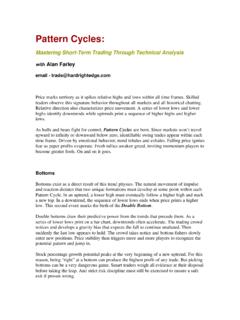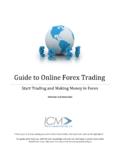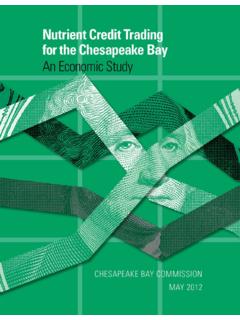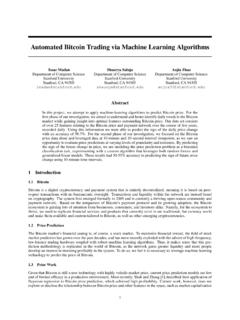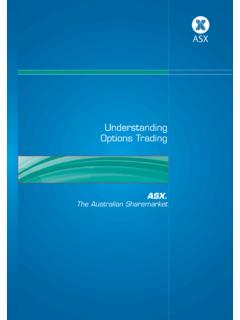Transcription of Swing Trading Using Candlestick charting with …
1 Swing Trading , pg. 1 Copyright 2002 by John L. Person III, CTAS wing Trading Using Candlestick charting with Pivot Point AnalysisWritten by John L. PersonIntroduction:This booklet was written with the intention of enlightening your knowledge and awareness of different techniques oftechnical analysis. As a professional trader and public speaker I strive to help educate my community of investorsand clients. As an example of my commitment to that goal I want to provide this manual to you. I believe thatcontinued education can help increase knowledge and through improved knowledge comes booklet is not designed to cover every detail of the material discussed but to help you to explore a new avenueor refresh your memory of material you may have learned previously.
2 About the Author:John Person is a 22-year veteran of the Futures and Options Trading industry. Since his start on the floor of theChicago Mercantile Exchange, he has worked his way throughout the industry as a Broker, Trader, BranchManager for one of Chicago's largest discount / full service firms under the tutelage of a former Chairman of theChicago Board of Trade. Early in his career, John worked as an apprentice for George C. Lane Credited with thecreation of the oscillating system known as Stochastics. In addition, John studied Candlestick charting techniquesby Dan Gramza, the man who helped Steve Nison from his first book. John has applied his knowledge throughoutthe years by appearing as a regular contributor on several financial television programs and as a keynote speakerat some of the countries top Investment Expositions.
3 In addition, John is the editor of "The Bottom-Line Newsletter",a weekly commodity publication that incorporates fundamental developments as well as technical analysis includinghis own proprietary Trading system- Using support and resistance levels on a daily, weekly and monthly basis. Thishelps his clients identify potential buy or sell signals on a short, intermediate or a long-term 1 Pivot Point Analysis is a famous technique that is used as a price forecasting method for day traders andprofessional traders as well. It is very popular among should have a better understanding of this method after reading and studying this booklet and the benefits toyou may help improve your timing of entry and exit points of the are numerous advisory services, brokerage firms and independent traders that use one form of it or /Resistance, price range forecasting pin pointing tops and bottoms and target Trading are some of theterms that are used to refer to it as well.
4 For most traders on the floor of the exchanges it is considered commonknowledge or old school of novice individual investors and even brokers are not familiar with this formula. I believe that mostinexperienced investors have a hard time with incorporating this technique in their Trading tool box due to the timeit takes to calculate the numbers. But make no mistake the professionals look at it and so should here is the mathematical formula where P= Pivot point; C= Close: H= High: and L= Pivot point number is the high, low, close added up and then divided by three. P=(H+L+C)/3= pivot pointNow for the first resistance level take the pivot point number times two and then subtract the low. (Px2)-L=Resistance 1 For the second resistance, take the pivot point number add the high and then subtract the low.
5 P+H-L= Resistance2 PDF created with FinePrint pdfFactory Pro trial version Trading , pg. 2 Copyright 2002 by John L. Person III, CTAFor the first support take the pivot point number times two and then subtract the high. (Px2)-H = Support 1 For the second support, take the pivot point number subtract the high and then add the low. P-H+L= Support 2 All right, now that we have that established you can see it is a detailed formula. So let s try to simplify it. Considerthe Pivot Point as the average of the previous sessions Trading range combined with the closing price. Thenumbers of support and resistance that are calculated indicate the potential ranges for the next time frame basedon the past weight of the markets strength or weakness derived from the calculations of the high, low and distancefrom the close of those points.
6 Pivot Point analysis is also used for identifying breakout points from the support andresistance previous sessions Trading range could be based and calculated for an hour, a day, a week or a month. Mosttrading software includes these numbers on a daily basis so that you do not have the tedious chore of doing it theold fashion way, by hand Using a calculator. The really old fashion way doesn t use a calculator. Don t make yourjob harder try the easy wrote a computer program so that I can calculate the numbers on a daily, weekly and monthly time periodrelatively quick and for most markets. These calculations are available to clients by Fax, email or by viewing on and visitors have access to this research by going to my website . I personally do the daily numbers at the end of the day in order to help me identify the next day s potential range orsupport and resistance.
7 It gives me a head start on my research so I am prepared for the next day s work. It helpsme to plan my trades. Similarly the weekly numbers are done at the end of every week and the same goes for themonthly most technical analysis is derived from mathematical calculations the common denominators that are usedare the high, low, close and the open. This is what is used for plotting a bar chart. More notarized techniques likeMoving averages, Relative Strength Index, Stochastics, and Fibonacci numbers are all calculated usingmathematics based on those points of interest. It is also what is published in the Newspapers. It is there for concept is this, as technical analysts we are trying to use past price behavior to help us indicate future pricedirection.
8 L I am not trying to predict the future I just want an Idea of where prices can go in a given time periodbased on where they have been. After all isn t that similar to the concept of drawing trend lines?CHAPTER 2We have all heard the slogan about how to be successful in investing in Real Estate, which is LOCATION,LOCATION, and LOCATION. (Check that out another symbolic reference that involves the Fibonacci numberthree). In this business it is important to remember what I call the rule of MULTIPLE VERIFICATION. I more than likelypicked this belief by reading a book back in 1981 0r 1982 by Arthur Sklarew. He wrote in his book titled Techniquesof a Professional Commodity Chart Analyst, about The Rule of Multiple Techniques (page 3) He know very well that the price chart analysis is not an exact science.
9 No single charttechnique yet discovered is infallible. Despite this lack of perfection, price chart analysis can very often give reliableforecasts of trend ..Confirmation is therefore an essential component of every valid chart signal. In addition to comparing price charts of different contract months and time scales, it has been my experience thatthe accuracy of any technical price forecast can be improved greatly by the application of a principle that I call the Rule of Multiple Techniques. The Rule of Multiple Techniques requires that the chart technician not rely solely on one single technical signal orindicator, but look for conformation from other technical indicators. The more technical indicators that confirm eachother, the better the chance of an accurate created with FinePrint pdfFactory Pro trial version Trading , pg.
10 3 Copyright 2002 by John L. Person III, CTAThe logic behind this rule is that if individual time proven techniques tend to be right most of the time, a combinationof several such techniques that confirm each other will tend to be right even more do not believe Mr. Sklarew talked about the Pivot Point analysis as a means of technical analysis nor was heaware at the time he wrote that book, of the art of Candlestick charting . I believe that had he, it would have morethan likely have been in his book. Verify, verify and verify. What it means to me is this, before deciding to invest or make a trade, if I understand theunderlying fundamentals, I would want to look at a chart to confirm the trend and then I would look at varyingtechnical indicators to help confirm my incorporating different techniques like pivot point analysis, the figures help me speed up my analytical these numbers I can take my charts and draw lines with the support and resistance numbers on them to see ifthey help clear the visual picture.


